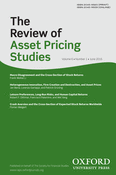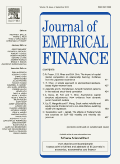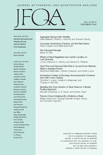
Review of Asset Pricing Studies
Scope & Guideline
Transforming Asset Pricing Studies for Tomorrow's Leaders
Introduction
Aims and Scopes
- Asset Pricing Models and Theories:
The journal emphasizes the development and testing of asset pricing models, including multifactor models and the intertemporal capital asset pricing model (ICAPM). Researchers contribute to the theoretical underpinnings of how asset prices are determined in financial markets. - Market Microstructure and Trading Behavior:
Studies often focus on the intricacies of market microstructure, including the effects of trading behavior, short selling, and the role of liquidity. This area explores how these factors influence asset pricing and market efficiency. - Risk Factors and Return Predictability:
The journal investigates various risk factors and their impact on return predictability across asset classes, including equities and bonds. This includes exploring characteristics such as size, value, and momentum. - Regulatory and Economic Impacts on Asset Pricing:
Research highlights the effects of regulatory changes and macroeconomic conditions on asset pricing, addressing how these external factors shape market dynamics and investor behavior. - Behavioral Finance and Investor Psychology:
The journal includes studies that incorporate behavioral finance principles, examining how investor psychology and sentiment affect asset pricing and market trends.
Trending and Emerging
- Cryptocurrency and Digital Assets:
There is a growing body of research focusing on the pricing mechanisms and investor behavior related to cryptocurrencies and digital assets, highlighting their increasing significance in the financial ecosystem. - Impact of Macro-Financial Dynamics:
Studies examining the interplay between macroeconomic indicators and asset pricing have gained prominence, suggesting a heightened interest in understanding how macroeconomic conditions influence market behavior. - Behavioral Insights into Investment Practices:
An emerging trend is the integration of behavioral finance concepts into asset pricing research, exploring how psychological factors and investor sentiment shape market outcomes and asset valuations. - Regulatory Effects on Market Behavior:
Research focusing on the implications of regulatory changes, such as short-selling regulations and their impact on market efficiency and pricing, has become more prevalent, reflecting the importance of policy in shaping financial markets. - Advanced Portfolio Management Strategies:
There is an increasing emphasis on innovative portfolio management strategies, including the use of machine learning and alternative data, to enhance asset pricing models and improve investment outcomes.
Declining or Waning
- Traditional CAPM Applications:
Research applying the Capital Asset Pricing Model (CAPM) has become less frequent, as scholars increasingly explore more complex and multifactor models that better capture the nuances of asset pricing in modern markets. - Focus on Historical Data Analysis:
There has been a noticeable decrease in studies that rely solely on historical data analysis without integrating contemporary market phenomena or advanced methodologies, indicating a trend toward more dynamic and forward-looking approaches. - Simple Return Predictability Models:
The exploration of simplistic return predictability models has waned as researchers shift towards more sophisticated techniques that incorporate macroeconomic variables and behavioral insights, reflecting a broader understanding of market complexities.
Similar Journals

JOURNAL OF PORTFOLIO MANAGEMENT
Empowering Finance Professionals with Rigorous ResearchJOURNAL OF PORTFOLIO MANAGEMENT is a premier academic journal dedicated to advancing the field of finance through rigorous research focused on investments, asset management, and portfolio strategies. Published by PAGEANT MEDIA LTD in the United States, this journal has established itself as a vital resource for finance professionals and scholars alike, as evidenced by its consistent ranking in the Q2 category across disciplines such as Accounting, Business Management, Economics, and Finance according to the latest categorization. With an emphasis on empirical studies and theoretical advancements since its inception in 1995, the journal remains a key player in the academic landscape, offering insights valuable for both researchers and practitioners. Although not an open-access journal, it provides access to high-quality, peer-reviewed articles that contribute significantly to the discourse on portfolio management. The ISSN for traditional publications is 0095-4918, while the E-ISSN is 2168-8656, ensuring wide-reaching dissemination of complex financial concepts. Immerse yourself in the latest findings to enhance your understanding and application of portfolio management strategies.

Journal of Empirical Finance
Empowering finance through rigorous empirical research.Journal of Empirical Finance, published by Elsevier, stands as a key resource in the areas of finance and economics, with a definitive focus on empirical studies. As a prominent journal since its inception in 1993, it has made significant strides in contributing to the academic community, evidenced by its soaring categorization in Q1 for Finance and Q2 for Economics and Econometrics as of 2023. With an ISSN of 0927-5398 and an E-ISSN of 1879-1727, the journal emphasizes robust, data-driven analysis to inform both theoretical and practical aspects of financial research. While access options do not include open access, the journal ensures that its content remains accessible to a diverse audience of researchers, professionals, and students. It fosters a platform for innovative research and discourse, significantly impacting the fields of finance, economics, and econometrics. The Scopus rankings further bolster its reputation, placing it in the 61st percentile in both categories, reflecting a commitment to high-quality research output. As the journal continues to evolve, it invites contributions that push the boundaries of empirical finance, enabling a deeper understanding of financial mechanisms that drive global economies.

JOURNAL OF FINANCIAL AND QUANTITATIVE ANALYSIS
Catalyzing Innovation in Quantitative Financial ResearchJOURNAL OF FINANCIAL AND QUANTITATIVE ANALYSIS, published by Cambridge University Press, is a premier peer-reviewed journal that has been at the forefront of the finance and economics fields since its inception in 1966. With a notable impact factor reflecting its Q1 status in Accounting, Economics and Econometrics, and Finance for 2023, the journal is recognized for its substantial contributions to both theoretical and empirical research. Researchers and practitioners alike benefit from its comprehensive scope, addressing critical issues in financial analysis and quantitative methods. Although the journal does not currently offer open access, it remains widely accessible through institutional subscriptions. The editorial team is committed to fostering rigorous academic discussions that shape the future of finance and economics, making it an essential resource for academics, students, and industry professionals seeking to deepen their understanding of these vital disciplines. For more than five decades, this journal has continued to be an indispensable platform for disseminating influential research, thus solidifying its role as an essential cornerstone in the financial and quantitative analysis community.

Journal of Risk
Empowering Research on Strategic Risk ManagementJournal of Risk, published by INCISIVE MEDIA, serves as an essential platform for scholars and practitioners in the fields of finance and strategic management. With an ISSN of 1465-1211 and an E-ISSN of 1755-2842, this journal explores the multifaceted nature of risk, encompassing theoretical frameworks, empirical investigations, and practical applications. Although currently classified in Q4 for both Finance and Strategy and Management categories as per 2023 standards, it provides a crucial forum for innovative research and thought leadership, addressing the challenges faced in understanding and managing risk in today’s dynamic environment. The journal, based in the United States, is committed to advancing knowledge and offering a platform for debate and dialogue in its convergence years from 2011 to 2024. Researchers, professionals, and students are encouraged to contribute their insights to enhance the academic discourse surrounding risk management.

Journal of Derivatives
Driving Excellence in Econometrics and Finance.Welcome to the Journal of Derivatives, a premier platform for the dissemination of cutting-edge research in the fields of Economics, Finance, and Econometrics. Published by PAGEANT MEDIA LTD, this esteemed journal has been a vital source of knowledge since its inception in 1996, with a commitment to fostering academic excellence through rigorous peer-reviewed studies. Though it presently does not operate under an open access model, the journal continues to maintain a respectable presence within its field, recognized as Q3 in both Economics and Finance as of 2023. Researchers and practitioners alike will find valuable insights and innovative methodologies, reflected in its competitive Scopus rankings, which place it among the best in its category. As the journal engages with a diverse array of topics related to derivatives and their applications, it serves as an essential resource for those seeking to deepen their understanding of financial instruments in today’s ever-evolving economic landscape. Join us in exploring the latest advancements and discussions in this critical area of study.

Journal of Investment Management
Bridging Theory and Practice in Investment Management.The Journal of Investment Management, with ISSN 1545-9144 and E-ISSN 1545-9152, is a prominent platform dedicated to the dissemination of cutting-edge research in the field of investment management. Published by JOURNAL INVESTMENT MANAGEMENT, this journal aims to bridge the gap between theoretical foundations and practical applications, catering to the needs of researchers, professionals, and students alike. With a focus on contemporary issues influencing investment strategies, asset allocation, risk management, and financial innovation, this journal provides valuable insights and methodologies to enhance investment decision-making processes. While currently not operating under an open-access model, the journal is accessible through various academic databases, ensuring that its critical findings reach a wide audience across the globe. Emphasizing the significance of empirical research and analytical rigor, the Journal of Investment Management plays a crucial role in shaping the future of investment practices and academic discourse in this dynamic field.

Annals of Finance
Exploring the Frontiers of Financial Theory and PracticeThe Annals of Finance, published by Springer Heidelberg in Germany, stands as a pivotal journal within the realms of Economics, Econometrics, and Finance. With a dedicated convergence of research from 2005 to 2024, this esteemed publication features thought-provoking articles that address both theoretical and practical aspects of finance, earning it a commendable Q2 category ranking in the 2023 metrics for both Economics, Econometrics and Finance as well as Finance. The journal serves an essential role in disseminating knowledge and fostering advancements in the field, appealing to researchers, professionals, and students alike. Its rigorous peer-review process ensures the integrity and quality of published works, making it a reliable source for cutting-edge findings and discussions within the finance community. For those looking to navigate the complexities of modern finance through rigorous research, the Annals of Finance is an invaluable resource.

SIAM Journal on Financial Mathematics
Connecting Theory and Practice in Financial MathematicsThe SIAM Journal on Financial Mathematics, published by SIAM PUBLICATIONS, is a premier journal dedicated to the intersection of applied mathematics and finance. With an ISSN of 1945-497X, this journal serves as a vital platform for the dissemination of innovative research that addresses complex financial problems through mathematical modeling and analytical techniques. The journal has established itself within the Q2 quartile in the categories of Applied Mathematics, Finance, and Numerical Analysis, reflecting its influence and significance in these fields. Researchers and practitioners will find a wealth of knowledge spanning topics from stochastic calculus to quantitative finance, making it essential for anyone aiming to advance their understanding of financial mathematics. As the journal continues to converge from 2010 to 2024, it promises to remain a cornerstone resource for academics, professionals, and students alike, facilitating the ongoing dialogue between mathematics and its applications in the financial industry.

Journal of Investing
Empowering strategic decisions through scholarly research.Welcome to the Journal of Investing, a critical platform dedicated to advancing knowledge in the fields of finance, strategy, and management of technology and innovation. Published by PAGEANT MEDIA LTD, this esteemed journal, with ISSN 1068-0896 and E-ISSN 2168-8613, provides a scholarly forum for researchers, practitioners, and educators to explore contemporary issues and innovative practices within the investment landscape. With a notable Q3 ranking in Finance, Management of Technology and Innovation, and Strategy and Management, the journal asserts itself as a pivotal resource, contributing to the academic dialogue in these crucial disciplines. Though it operates under a traditional access model, the journal is committed to publishing high-quality research that influences both theoretical and practical dimensions of investing. Join us in exploring vital insights that drive the investment community forward, fostering informed decision-making and strategic development.

Annals of Economics and Finance
Fostering Critical Discourse in Economics and Finance.Annals of Economics and Finance is an esteemed academic journal published by Wuhan University Journals Press, focusing on the fields of Economics and Finance. Established in 2000, this journal serves as a platform for scholars to disseminate their research findings and insights, contributing to the development of these disciplines through rigorous peer-reviewed articles. Despite currently holding a Q4 ranking in both Economics and Econometrics and Finance categories (2023), it strives to enhance its impact on the academic community and policy-making audiences. While not Open Access, the journal seeks to cultivate a deeper understanding of vital economic theories and financial practices, thereby offering invaluable resources for researchers, professionals, and students alike. With its broad scope, the Annals of Economics and Finance is poised to play a crucial role in shaping contemporary economic discourse up to 2024 and beyond.